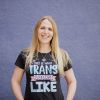Gender: how fair is the German language?
How can the German language be made fairer – and is this necessary at all?

Linguistics is a science that is rarely in the spotlight. But for some years now, an often heated discussion has flared up repeatedly in Germany about how the German language can be made fairer – and whether this is even necessary at all. It’s not just a matter of sensitivities, but also of linguistics.
One of the main issues in the struggle for a fairer German language is the grammatical plural. “Ein Arzt” (male doctor) and “eine Ärztin” (female doctor) are entirely correct in the singular form. However, if a group consists of 99 female doctors and one male doctor, they are collectively referred to as “doctors” using the masculine form as the default. Grammatically, it can therefore be said that the one man takes precedence over all the women. In linguistic terms, this is called the “generic masculine” – an abstract plural that includes both men and women. Why has an argument erupted over this issue?
Women are made invisible
Language traditionalists maintain that of course women know the masculine plural form of “doctors” also applies to them. But the highly-respected feminist linguist Luise F. Pusch disagrees: “The generic masculine is better at making women invisible than a burka.”
Quick facts
Christine Olderdissen, who runs the website www.genderleicht.de, is also convinced that the supposedly neutral plural actually disadvantages women in reality. “There are numerous studies on this,” she says.“ For example, it has been proven that female school students feel more attracted to typically male-dominated jobs, such as a car mechanic, if the job title also includes the female form, i.e.‘Automechaniker’ (male form)/‘Automechanikerin’ (female form).”
Making diversity visible
Genderleicht.de, a project run by the Journalistinnenbund (association of female journalists), is funded by the Ministry for Family Affairs and provides tips and support on non-discriminatory writing and speech. “We want to make diversity visible without imposing strict regulations,” says Christine Olderdissen. It’s not about “correct reporting”, she says, but about “specific reporting”. “If women, transgender people or intersex people are meant, the text should explicitly refer to them as such.”
The Verein Deutsche Sprache (an association for the German language) opposes such attempts at linguistic reform. The association, which has over 36,000 members, complains that gender-inclusive language is producing a host of “ridiculous language constructs”. Since March 2019, some 73,000 people have signed a VDS petition unambiguously entitled “Stop this gender nonsense”, among them well-known authors such as Katja Lange-Müller and Judith Hermann.
Gender-inclusive language is based on the general misunderstanding that there is a connection between biological sex and grammatical gender, write the petition’s instigators. The self-appointed preservers of the language fear the rise of linguistic monstrosities such as “Bürger_innenmeister_innen” or artificial, neutral participles like “die Radfahrenden”, “die Fahrzeugführenden” and “die Arbeitnehmenden”.
No room in duden for the gender star
Despite this opposition, an awareness of this issue has arisen particularly in public and political institutions, authorities, universities and in many companies. For longer words in some contexts, the gender star, or asterisk, has become established between the word stem and the feminine ending – e.g. “Programmierer*innen”. This is intended to express not only masculine and feminine identities, but other gender identities too. Hanover is the first German city to use gender-inclusive language in its official communications and now consistently refers to citizens as “Bürger*innen”.
The gender star is yet to be granted official recognition, however. In 2018, the Rat für deutsche Rechtschreibung (Council for German Orthography), publisher of the Duden dictionary, decided not to include the gender star in its bible of the German language for the time being. The reason for this was that the gender star has a couple of competitors. The underscore or “gender gap” (“Bürger_Innen”) and the capital I in the middle of words (“BürgerInnen”) are both also used as gender-inclusive alternatives.
Diversity is enriching
Other people strongly prefer neutral participle forms such as “Studierende”. However, neutrality in the German language comes to a halt at the article. “Der Studierende” and “die Studierende” are clearly separated into masculine and feminine forms, leaving no room for the “other” (third gender) option recently introduced in Germany. The neutral article “es” – i.e. “das Studierende” – would be grammatically possible, but is rejected by many people on the grounds that “es” is primarily used for objects and children. One highly-original way of getting around the issue is the gender x, which eliminates all grammatical gender classifications: “Dex gutx Studierx”.
Christine Olderdissen of www.genderleicht.de finds this diversity confusing, but ultimately also enriching. “Language is dynamic and is constantly evolving. It’s great how media producers in all sectors are dealing with the challenge of gender-inclusive language in such inventive ways.” The journalist believes it would be wrong to impose a blanket regulation on language for all texts. “A tabloid newspaper with short headlines needs to use different language from a scientific paper.”
With this in mind, the website offers a “text laboratory” where specific problems can be solved. For example, an equal opportunities officer requested suggestions for an alternative to “Bürgerhaus” (community centre). “‘Bürger*innenhaus’ was too complicated,” explains Christine Olderdissen, “as were ‘Bürgerinnen’ und ‘Bürgerhaus’”. The solution that was finally reached had no gender at all: “Haus der Begegnung” (meeting house).
The article was originally published by Alumniportal Deutschland.
Find the article here

